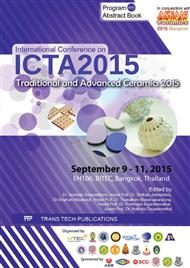p.81
p.87
p.92
p.97
p.103
p.109
p.114
p.120
p.126
Phenol Removal from Contaminated Wastewater Using Activated Carbon/Zeolite Composite Coated with Titanium Dioxide
Abstract:
Phenol and phenolic compounds in wastewater from various industries were toxic to water livings and human even in ppm concentration. A number of photocatalysts and adsorbents were applied for the low cost and good efficiency wastewater management to reduce phenol concentration in water. In this work titanium dioxide, one of high efficiency photocatalysts which is widely used in water treatement, was coated on the fabricated adsorbent composite substrate. The composite substrate composed of activated carbon and NaA zeolite presents high phenol adsorption because of high porosity and good ion exchange properties resulting in good adsorption property. Accordingly, the absorption could promote the photocatalytic activity of TiO2 catalyst. As the specimens were easily disposed after water treatment process, therefore, it was a good choice for lower energy consumption. The composite substrate was easily fabricated by simple extrusion and fired under non oxidation atmosphere at 650°C for 3 hours. Then polyurethane foam was inserted into the composite substrate to make it be able to float and be swirled by wind near water surface to get more UV excitation than deeper water. Phenol concentration was investigated by the UV absorbance at 270 nm using UV-Vis spectrophotometer. The XRD and SEM were used to study phase crystal structure and morphology of the composite.
Info:
Periodical:
Pages:
103-108
Citation:
Online since:
May 2016
Keywords:
Price:
Сopyright:
© 2016 Trans Tech Publications Ltd. All Rights Reserved
Share:
Citation:


